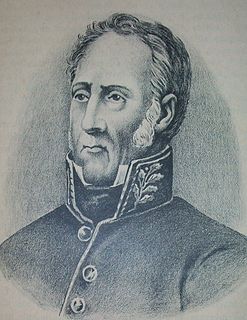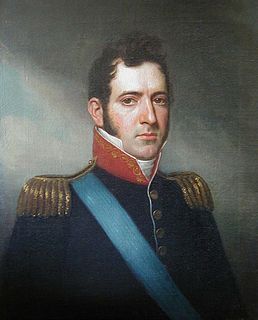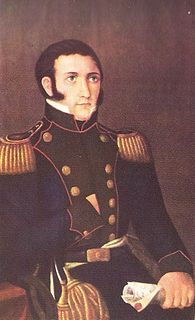
The Casa Rosada is the executive mansion and office of the President of Argentina. The palatial mansion is known officially as Casa de Gobierno,. Normally, the President lives at the Quinta de Olivos, the official residence of the President of Argentina, which is located in Olivos, Greater Buenos Aires. The characteristic color of the Casa Rosada is baby pink, and is considered one of the most emblematic buildings in Buenos Aires. The building also houses a museum, which contains objects relating to former presidents of Argentina. It has been declared a National Historic Monument of Argentina.
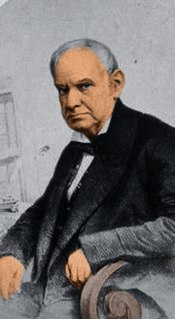
Alejandro Vicente López y Planes was an Argentine writer and politician who acted as interim President of Argentina from July 7, 1827 to August 18, 1827. He also wrote the lyrics of the Argentine National Anthem adopted on May 11, 1813.

Juan Facundo Quiroga was an Argentine caudillo who supported federalism at the time when the country was still in formation.
The First Triumvirate was the executive body of government that replaced the Junta Grande in the United Provinces of the Río de la Plata. It started its functions on September 23, 1811, and was replaced on October 8, 1812.

Unitarianists or Unitarians were the proponents of the concept of a unitary state in Buenos Aires during the civil wars which shortly followed the Declaration of Independence of Argentina in 1816. They were opposed to the Argentine Federalists, who wanted a federation of independent provinces.

The Argentine National Historical Museum is located in Buenos Aires, Argentina, and is a museum dedicated to the history of Argentina, exhibiting objects relating to the May Revolution and the Argentine War of Independence.

Argentine postage stamps were first issued in 1858 by the Argentine Confederation and nationally by the new Republic's National Postal Service in 1862. Due to the continuing civil wars, a number of provinces and territories, particularly in the then-remote far north and far south, continued to issue their own postage brands and stamps for some time, afterwards; some of these issues have since become collectors' items.

Avenida Rivadavia is one of the principal thoroughfares in Buenos Aires, Argentina, extending 23 miles (37 km) from downtown Buenos Aires to the western suburb of Merlo.

Rogelio Yrurtia was a renowned Argentine sculptor of the Realist school.
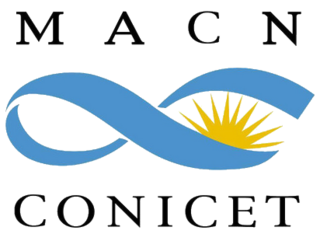
The Bernardino Rivadavia Natural Sciences Argentine Museum is a public museum located in the Caballito section of Buenos Aires, Argentina.

The Gazeta de Buenos Ayres [sic] was a newspaper originating in Buenos Aires, United Provinces of the Río de la Plata, in 1810. It was initially used to give publicity to the government actions of the Primera Junta, the first post-colonial Argentine government. In the beginning it was written by Mariano Moreno, with the aid of the priest Manuel Alberti; Manuel Belgrano and Juan José Castelli were also part of its staff.

The Anniversary of the First National Government is a public holiday of Argentina, commemorating the May Revolution and the creation on May 25, 1810 of the Primera Junta, which is considered the first patriotic government of Argentina. Along with the 9 July, which commemorates the Declaration of Independence, it is considered a National Day of Argentina.

Historia de San Martín y de la emancipación sudamericana is a biography of José de San Martín, written by Bartolomé Mitre in 1869. Along with his biography of Manuel Belgrano, it is one of the earliest major works of the historiography of Argentina.
The Revolution of October 8, 1812 took place during the Argentine War of Independence. Led by José de San Martín and Carlos María de Alvear, it deposed the First Triumvirate and allowed the creation of the Second Triumvirate, which called the Assembly of Year XIII.
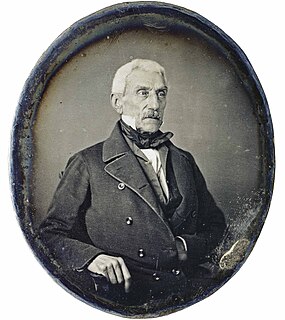
The later life of José de San Martín documents the life of San Martín after his retirement from the Spanish American wars of independence. He met Simón Bolívar at the Guayaquil conference, resigned from his political offices in Peru and handed him the command of the Army of the Andes. San Martín returned to Argentina, and then left for Europe. He spent his later life in France, and died in Boulogne-sur-Mer on August 17, 1850.

The Argentine Constitution of 1826 was a short-lived Constitution of Argentina drafted during the Argentine Civil Wars. Bernardino Rivadavia was appointed President of Argentina under this constitution. It was rejected by most Argentine provinces, and then abolished.

